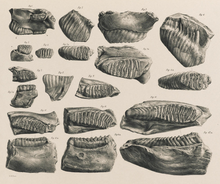古亚洲象
| 古亚洲象 化石时期:
| |
|---|---|

| |
化石
| |
| 科学分类 | |
| 界: | 动物界 Animalia |
| 门: | 脊索动物门 Chordata |
| 纲: | 哺乳纲 Mammalia |
| 目: | 长鼻目 Proboscidea |
| 科: | 象科 Elephantidae |
| 属: | 象属 Elephas |
| 种: | 古亚洲象 E. hysudricus
|
| 二名法 | |
| Elephas hysudricus ( Falconer and Cautley, 1845)
| |
| 异名 | |
|
Hypselephas hysudricus | |
古亚洲象(学名:Elephas hysudricus)是一种已灭绝的象科动物,化石发现于西瓦利克山脉。生活在上新世和更新世时期[1]。 化石最早在印度博尔德下更新世砾岩带的侵蚀沉积而成。同地层也发现华丽剑齿象(Stegodon ganesha)、双角犀(Dicerorhinus platyrhinus)、印度马 (Equus sivalensis) 和印度骆驼 (Camel sivalensis)等。 古亚洲象的颅骨与非洲菱齿象的颅骨大不相同。它们的臼齿相对较短,较类似于东印度和日本古菱齿象的某些种类。 Falconer 和 Cautley以及 Osborn曾描绘此种古亚洲象幼年颅骨有极大的头颅指数(颅宽*100/颅长),与Blainville 描绘的 Elephas indicus 的幼年颅骨非常相似。 这些高而压缩的颅骨与非洲菱齿象低而扁平的幼年颅骨大不相同。 在咀嚼面可观察到不明显的中尖突(loxodont-sinus)[2]
参考文献[编辑]
- ^ Nanda, A. C. Upper Siwalik mammalian faunas of India and associated events. Journal of Asian Earth Sciences. 2002, 21 (1): 47–58. doi:10.1016/S1367-9120(02)00013-5.
- ^ Proboscidea : a monograph of the discovery, evolution, migration and extinction of the mastodonts and elephants of the world(II)p.1340 By Osborn, Henry Fairfield, 1857-1935.
|
